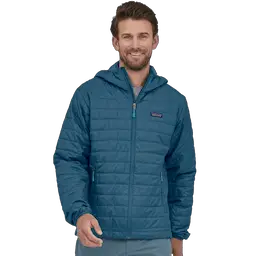When searching for options for a puffy for a thru-hike, many will opt for down-filled jacket choices, and others may need or choose synthetic.
A huge consideration needs to be how small they can pack down to and the relative moisture in the area through precipitation or sheer humidity.
Today I want to cover the Nano Puff vs. Micro Puff for use on the trail, along with their relative benefits and drawbacks and the best jacket.
For my quick answer regarding these two Patagonia jackets, the Nano Puff is more durable and weather-resistant than the Micro Puff. The Micro Puff is smaller and still packs the same warmth as the Nano Puff.
If you are looking for a synthetic paired with an exceptionally high warmth-to-weight ratio, then the choice is the Micro; check the latest price here at Backcountry.
Intro to the Patagonia Brand
It was more than ten years ago when PrimaLoft synthetic insulation, which is built from recycled materials, was the new “popular” thing in the outdoor scene. It became the go-to choice for non-down gear, being warmer, lighter, and more compressible than other synthetics on the market.
Patagonia was an early adopter of using PrimaLoft Gold Eco insulation in their gear, like the Nano Puff outerwear line.
Patagonia believes that when you buy a piece of equipment, you should purchase it for life, and all their clothing is expected to live up to that motto.
What is the Patagonia Nano Puff?
The Patagonia Nano Puff is a synthetic insulated jacket that has been purpose-built for use in the alpine and on long mountain expeditions.
Its main feature is its PrimaLoft Gold insulation, made from recycled post-consumer plastics, and offers an exceptional warmth-to-weight ratio.
The Nano Puff is also highly packable, compressible, and durable, thanks to its ripstop nylon shell fabric.

Patagonia Nano Puff
The Patagonia Nano Puff is a popular lightweight, warm, and packable jacket made by outdoor gear company Patagonia. Here are some key details about the Patagonia Nano Puff jacket:
- Insulation – It uses PrimaLoft Gold Insulation Eco, a synthetic insulation designed to provide warmth even when wet. The insulation is very compressible and lightweight.
- Windproof – The outer fabric is windproof to help block wind and retain warmth. It’s made from lightweight and recycled polyester ripstop fabric.
- Water Resistant – The outer fabric has a DWR (durable water repellent) finish to repel light moisture. It’s not fully waterproof but can handle light rain and snow.
What is the Patagonia Micro Puff?
The Patagonia Micro Puff is an ultralight synthetic insulated jacket designed as a mid-layer or outer layer in cold weather.
It’s made with a super lightweight shell and lining fabric, filled with 65 g of lightweight PlumaFill insulation, their proprietary synthetic insulation developed by Patagonia.
It’s also simple to compress and can be stuffed into its pocket for easy storage. Most thru-hikers can wedge it into an open space within their backpack with ease due to less overall synthetic material.

Patagonia Micro Puff
The Patagonia Micro Puff is also a lightweight, packable, insulated jacket made by Patagonia, but it’s even more lightweight and compressible than the classic Nano Puff. Here’s an overview:
- Insulation – It uses 10-denier PlumaFill insulation, which is Patagonia’s lightest and most compressible synthetic insulation. This makes the Micro Puff very warm for its low weight.
- Extremely Lightweight – The Micro Puff weighs just under 5 oz for a men’s medium size. It’s one of the lightest insulated jackets on the market.
- Extremely Packable – Due to the lightweight materials, the Micro Puff can be packed very small into its chest pocket. When packed down, it’s about the size of a granola bar.
Seven Big Key Differences Between the Nano Puff and the Micro Puff
Micro Puff is the way to go if you’re looking for the right option regarding price and quality. The two products are neck-and-neck as far as numbers go, but Micro Puff comes out more often than not in gram savings for ultralight backpackers.
Let’s compare the data between the Patagonia Nano Puff and Micro jackets.
Compressibility
It’s worth noting that synthetics aren’t as packable and compressible as down jackets. Still, when you look at these two, you are looking at the materials and the thickness within them as the deciding factor.
Nano Puffs are filled with 60g of PrimaLoft Gold Eco, made of recycled post-consumer plastics. It is also designed in a quilted pattern to keep the feathers from moving around and clumping together, which means it can loft better and maintain its original shape.
The Micro Puff is filled with 65g of PlumaFill, proprietary synthetic insulation developed by Patagonia. It is also designed to loft better and maintain its original shape.
The bottom line: If you’re looking for the most compressible synthetic, go with the Micro Puff.
Weight
Between these two, you are looking at a difference of about 3 ounces. For some, that might not seem like a lot, but for others, every ounce counts.
The Nano Puff is 12.3 ounces, while the Micro Puff is 9.3 ounces.
The bottom line: The Micro Puff is ultralight; if weight is your primary concern, this is the jacket for you.
Design
These jackets differ in the sewing pattern and how the sewing is done along the back, with the Micro Puff having a more stylish pattern in its baffle design.
The Nano Puff has a baffle design, the traditional way to sew synthetic insulation into a garment. This creates little pockets or compartments for the insulation to sit in, which helps it loft better and maintain its original shape.
The Micro Puff has an innovative quilt-through construction. This makes the jacket lighter and more packable, eliminating cold spots with some baffle construction.
The bottom line: If you’re looking for a more stylish design, go with the Micro Puff. If you’re looking for traditional box construction, go with the Nano Puff.
Warmth
While down puffy jackets will lean heavily into the FP or Fill Power, and synthetic fill will differ. The warmth-to-weight ratio is the big one to look at here, where the nano puff vs. micro puff tends to differ.
The Micro Puff has a higher warmth-to-weight ratio, meaning it will insulate better than the Nano Puff for its weight. However, the Nano Puff has a higher overall warmth rating, which will insulate better.
The bottom line: If you’re looking for an ultralight option that keeps you warm, the Micro Puff is the way to go. The Nano Puff is great if you need more warmth and don’t mind a few extra ounces.
Durability
As you may expect from the above remarks, Patagonia Micro Puffy Jacket uses newer and lighter fabrics, making it less durable than the tried-and-true Nano Puff.
The bottom line: If you’re looking for a more durable option, go with the Patagonia Nano Puff Jacket. The Micro Puff Hoodie is also great if you don’t mind sacrificing some durability for weight savings.
Versatility
The Micro is much better and more versatile as it is lighter and has a better warmth-to-weight ratio combined with newer insulation technology.
The Nano offers more durability with tougher fabrics, so depending on how you treat your puffy jackets, this may weigh heavily into your choice.
The bottom line: The Micro Puff is more versatile than the Nano Puff.
Price
The Micro Puffy is more expensive; it uses newer insulation and weighs less, leading to a better warmth-to-weight ratio.
The Nano Puff is cheaper, uses older insulation, and weighs more but has a higher overall warmth rating.
The bottom line: The Micro Puff is the better option if you’re looking for the highest quality synthetic. The Nano Puff is a great choice if you’re on a budget or don’t mind sacrificing a few ounces.
Water Resistance
Each sports DWR, or Durable Water Repellent, a synthetic polymer applied to the jackets’ exteriors. DWR causes water to bead up and roll off the fabric rather than soak in.
The Nano Puff has a ripstop nylon exterior with a DWR finish, making it more resistant to tearing and abrasion. The Micro Puff has a polyester shell with a DWR finish, making it more resistant to wind and moisture.
The bottom line: If you’re looking for a more water-resistant option, go with the Nano Puff. The Micro Puff is better if you’re looking for a more wind-resistant option.
Is the Micro Puff or Nano Puff Warmer?
The two jackets are very much alike, with only the materials being a little different between them, so which is warmer, the micro puff or nano puff?
The Micro Puff is the warmer of the two, hands down. It’s made with a super lightweight shell and lining fabric, filled with 65 g of lightweight PlumaFill insulation, their proprietary synthetic insulation developed by Patagonia.
The Nano Puff is also highly packable, compressible, and durable; the ripstop fabric is perfect for stopping tearing on the trail. However, it’s not as warm as the Micro Puff.
So, the Micro Puff is the better option if you’re looking for a jacket to keep you warm in cold weather.
Final Thoughts on Choosing the Nano Puff vs Micro Puff For a Thru-Hike
So, which is better? The nano puff or the micro puff?
The answer depends on you. If you’re looking for the lightest and most compressible synthetic, go with the Micro Puff. The Nano Puff is a great choice if you need a little more warmth and don’t mind a few extra ounces.
For thru-hikers, the weight difference plays a part but also costs. For most, either lightweight jacket is a solid performer, but you must make sure you choose the hooded option at a minimum.
For those who are allergic to down, then this is as close to a no-brainer as you can find. The Micro Puff Hoody (hoodie?) has all the ingredients you could ever want for a thru-hike: ultralight, synthetic, hooded, and packed down small.
The Nano Puff is still an excellent choice but comes at a slightly higher price and weight. I recommend this to those looking for more warmth on a thru-hike or who like the brand and want to support Patagonia.
If you are looking for an ultralight synthetic insulated jacket that packs down small, go with the Micro Puff. If you want more warmth and weather resistance, choose the Nano Puff.


Leave a Comment